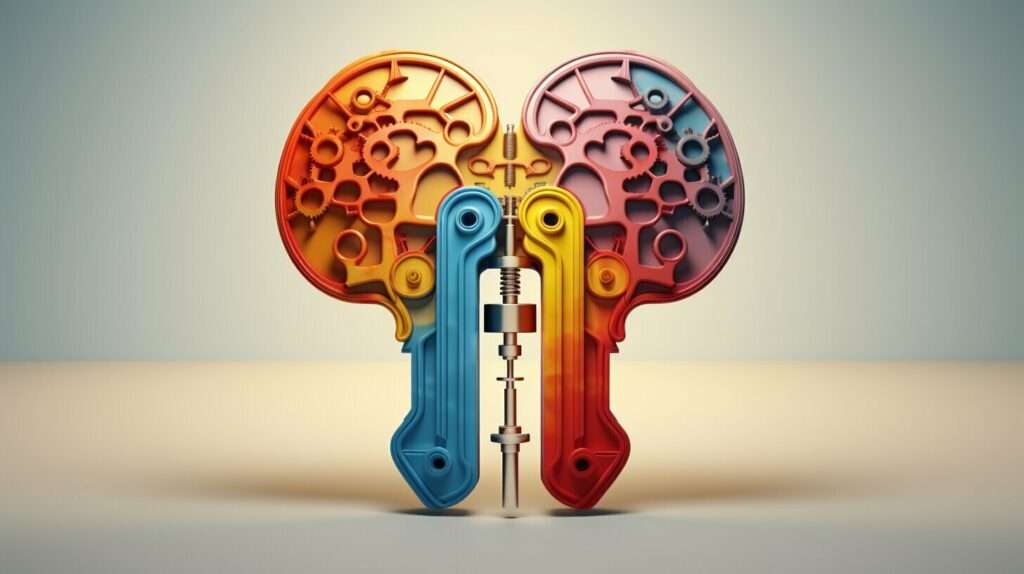Have you ever felt overwhelmed by your emotions, unable to control your mood swings? You’re not alone. Millions of people struggle with regulating their emotions, leaving them feeling helpless and out of control. However, recent research has uncovered a powerful tool that could help you take back control of your moods – your brain’s thalamus.
The thalamus is a small but mighty structure located deep within your brain. It acts as a “relay station,” processing and relaying information between different areas of your brain. While its role in perception and sensory processing has been well-studied, recent findings have shed light on its crucial role in regulating emotions.
So, how exactly does the thalamus hold the key to controlling your moods? And what can you do to harness its power and regulate your emotions? In this article, we’ll dive into the fascinating world of thalamic neuroscience and explore how you can use this knowledge to take control of your moods.
Key Takeaways:
- The thalamus is a small but essential structure in the brain, acting as a relay station for sensory information
- New research has uncovered its crucial role in regulating emotions and controlling moods
- Understanding the thalamus and its function can help you take control of your emotions and regulate your moods effectively
Understanding the Brain’s Thalamus and Its Function
The thalamus is a small, yet powerful structure located at the center of the brain. It acts as a relay station, receiving sensory information from the body and transmitting it to the appropriate regions of the brain for further processing. In addition to its sensory processing functions, the thalamus plays a crucial role in regulating mood and emotions.
Research has shown that the thalamus is involved in the production and regulation of alpha waves, which are associated with a state of wakeful relaxation. This suggests that the thalamus plays a role in promoting calmness and reducing anxiety. Additionally, the thalamus has connections to many other areas of the brain, including the prefrontal cortex, which is involved in decision-making and complex thought processes.
Interestingly, the thalamus is also involved in the sleep-wake cycle. It receives input from the body’s internal clock, which helps to regulate sleep patterns and ensure that we are awake during the day and asleep at night.
| Key Points: | The thalamus is a relay station in the brain that processes sensory information and regulates mood and emotions. |
|---|---|
| The thalamus is involved in the production and regulation of alpha waves, promoting calmness and reducing anxiety. | |
| The thalamus has connections to many areas of the brain, including the prefrontal cortex and the body’s internal clock. |
Thalamus and Emotions
The thalamus is one of the primary regions of the brain involved in emotional processing. It receives input from the amygdala, which is responsible for detecting and responding to emotional stimuli, and the prefrontal cortex, which is involved in the regulation of emotions.
Research has also shown that the thalamus plays a crucial role in the gating of emotional information. This means that it filters incoming emotional stimuli and determines which information should be relayed to other areas of the brain for further processing. This gating of emotional information is important for maintaining emotional stability and preventing overwhelming feelings of anxiety or fear.

Neuroscience and the Thalamus
Advances in neuroscience have led to a greater understanding of the thalamus and its role in regulating mood and emotions. For example, neuroimaging techniques such as functional magnetic resonance imaging (fMRI) have revealed that the thalamus is structurally and functionally different in individuals with mood disorders such as depression and anxiety.
Research has also indicated that the thalamus may be involved in the development and maintenance of chronic pain. This highlights the interconnectedness of the thalamus with other areas of the brain and the potential impact that dysfunction in this area can have on overall health and well-being.
- The thalamus is important for maintaining emotional stability and preventing overwhelming feelings of anxiety or fear.
- Neuroimaging has revealed structural and functional differences in the thalamus in individuals with mood disorders.
- The thalamus may be involved in chronic pain and overall health and well-being.
The Thalamus-Emotion Connection: Unveiling the Link
Now that you have a basic understanding of the brain’s thalamus and its function, let’s dive deeper into its role in controlling your moods. Neuroscience research has uncovered a strong connection between the thalamus and emotional processing, highlighting the pivotal role this region plays in regulating our emotions.
Specifically, the thalamus serves as a relay station for sensory information, receiving and transmitting signals to other brain regions involved in emotional processing, such as the amygdala and prefrontal cortex. This processing occurs rapidly and subconsciously, allowing us to quickly assess and respond to emotional stimuli from our environment.
Research suggests that the thalamus may also play a significant role in the development of mood disorders, such as depression and anxiety. Dysfunctional communication between the thalamus and other brain regions involved in mood regulation may contribute to the manifestation of these disorders.

Interestingly, studies have also shown that the thalamus exhibits the ability to adapt and reorganize itself in response to changes in sensory input and other environmental factors. This neuroplasticity further underscores the importance of the thalamus in emotional regulation and suggests its potential as a target for therapeutic interventions.
In the next section, we’ll explore the specific link between the thalamus and mood disorders, shedding light on the current state of research in this area.
The Thalamus and Mood Disorders
Mood disorders, such as depression and bipolar disorder, can be debilitating conditions that significantly impact your quality of life. Research has shown that the brain’s thalamus plays a crucial role in mood regulation and can be a target for treatment.
Studies have found that individuals with mood disorders have decreased activity in the thalamus, which may contribute to symptoms such as low mood and anhedonia (loss of pleasure in activities that were previously enjoyable).
Additionally, there is evidence to suggest that abnormalities in the thalamus may contribute to the development and maintenance of mood disorders.
Understanding the role of the thalamus in mood disorders has led to the development of new treatments that target the thalamus, such as deep brain stimulation (DBS) and transcranial magnetic stimulation (TMS).
These treatments aim to modulate activity in the thalamus and improve mood symptoms in individuals with mood disorders. While these treatments are still being studied, they offer hope for individuals who have not responded to traditional treatments for mood disorders.

The thalamus plays a crucial role in mood regulation and individuals with mood disorders may have decreased activity in the thalamus.
In addition to these targeted treatments, addressing lifestyle factors such as exercise, sleep, and stress management may also improve thalamic health and mood regulation.
If you are struggling with mood disorders, it is important to work with a mental health professional to determine the best treatment plan for you. By understanding the role of the thalamus in mood regulation and utilizing targeted treatments, you can take steps towards improving your mental health and overall well-being.
The Role of the Thalamus in Emotional Processing
Now that we understand the function of the thalamus and its connection with emotions, it’s important to explore its role in emotional processing. The thalamus is responsible for receiving sensory information from the body and relaying it to the relevant parts of the brain for further processing. This includes sensory input related to emotions.
Research has shown that the thalamus plays a crucial role in processing emotional information and modulating the intensity of emotional responses. For example, the thalamus is involved in regulating the fear response and influencing the perception of pain. It also plays a role in linking sensory experiences with emotional meaning, such as the association between a certain smell and a specific memory or emotion.
Moreover, studies suggest that the thalamus is involved in the regulation of emotions and may be implicated in various mood disorders. Dysregulation of the thalamus can lead to an overactive stress response, which may contribute to the development of anxiety and depression.

Understanding the role of the thalamus in emotional processing is crucial for developing targeted treatments for mood disorders. By targeting the thalamus, researchers may be able to develop more effective therapies for conditions such as anxiety and depression.
Furthermore, by taking steps to support thalamic health, you may be able to improve your own mood regulation and emotional well-being. This includes engaging in practices that promote brain health and emotional regulation, such as regular exercise, quality sleep, stress management, and mindfulness techniques.
Emphasize the Importance of Taking Care of Your Brain’s Thalamus
“The thalamus is a critical hub for sensory and emotional processing, and its health and function are crucial for maintaining emotional balance and well-being. By taking steps to support thalamic health, you may be able to unlock the key to controlling your moods and promoting emotional health.”
The Role of Neuroplasticity in Thalamic Function
Neuroplasticity, also known as brain plasticity, refers to the brain’s ability to change and adapt in response to experiences and stimuli. The thalamus is no exception to this rule, and research has shown that the thalamus exhibits significant neuroplasticity in response to changes in mood, environment, and behavior.
This process of neuroplasticity allows the thalamus to reorganize and establish new neural connections, which can lead to improved mood regulation and emotional processing. For example, studies have shown that mindfulness-based interventions can promote changes in thalamic activity and increase gray matter density, leading to improved emotional regulation and decreased symptoms of depression and anxiety.
| Benefits of Neuroplasticity on Thalamic Function |
|---|
| Improved mood regulation |
| Enhanced emotional processing |
| Increased gray matter density |
Furthermore, neuroplasticity can be influenced by various lifestyle factors, such as diet, exercise, and sleep. For example, aerobic exercise has been shown to increase brain-derived neurotrophic factor (BDNF), a protein that supports the growth and maintenance of neurons, including those in the thalamus.

By incorporating healthy lifestyle habits and practicing mindfulness techniques, you can promote neuroplasticity and support healthy thalamic function. This can lead to improved mood regulation, enhanced emotional processing, and better overall mental health.
The Key to Emotional Balance Lies Within Your Brain’s Thalamus
Your brain’s thalamus is a powerful tool for controlling your moods, but like any tool, it needs maintenance and care. Here are some strategies for enhancing thalamic function and mood regulation:
- Practice mindfulness: Mindfulness meditation has been shown to increase activity in the thalamus and improve mood regulation.
- Exercise regularly: Regular exercise has been shown to increase thalamic volume and connectivity, leading to improved mood regulation.
- Get adequate sleep: Sleep deprivation can negatively impact thalamic function and mood regulation.
- Reduce stress: Chronic stress can lead to thalamic dysfunction and mood imbalances. Try stress-reducing techniques like deep breathing or yoga.
- Seek professional help: If you are struggling with mood disorders or other mental health issues related to thalamic dysfunction, seek the help of a licensed mental health professional.
By implementing these strategies, you can unlock the full potential of your brain’s thalamus and take control of your emotions and mood.

Therapeutic Approaches Targeting the Thalamus
If you’re struggling with mood disorders or have difficulty regulating your emotions, therapeutic approaches targeting the brain’s thalamus may offer new hope for relief.
One such approach is transcranial magnetic stimulation (TMS), a non-invasive technique that uses magnetic fields to stimulate nerve cells in the brain. TMS has shown promise in treating depression, anxiety, and other mood disorders by targeting the thalamus and other key areas of the brain involved in mood regulation.
Another emerging approach is neurofeedback, which uses real-time information from brain activity to help individuals learn to regulate their own brain function and, in turn, their mood. Neurofeedback sessions may involve placing sensors on the scalp to monitor brain wave activity and providing immediate feedback in the form of visual or auditory cues. Studies have shown that neurofeedback can be effective in reducing symptoms of depression and anxiety, and may offer new avenues for thalamic-focused treatment.
Other therapeutic approaches targeting the thalamus include traditional talk therapy, cognitive-behavioral therapy (CBT), and medication. While each approach works via different mechanisms, they share a common goal: to help individuals better regulate their emotions and improve overall mental health.

If you’re struggling with mood disorders or emotional regulation, don’t lose hope. You have options. Talk to your healthcare provider about whether therapeutic approaches targeting the thalamus may be right for you. With the right treatment, you can take control of your moods and find emotional balance.
The Impact of Lifestyle Factors on Thalamic Health and Mood
Your lifestyle choices can have a significant impact on the health of your brain’s thalamus and, consequently, your mood regulation. Here are some factors to pay attention to:
- Exercise: Regular physical activity has shown to increase the volume of the thalamus, which can lead to improved mood regulation.
- Sleep: Lack of sleep has been linked to decreased thalamic activity and mood disorders. Aim for seven to eight hours of sleep per night.
- Nutrition: A diet rich in antioxidants, omega-3 fatty acids, and B vitamins has been associated with improved thalamic function and better mood regulation.
- Stress management: Chronic stress can damage the thalamus and lead to mood disorders. Finding healthy ways to manage stress, such as meditation or therapy, can help improve thalamic health.
By making positive lifestyle choices, you can improve the health and function of your brain’s thalamus, leading to better mood regulation and overall mental health.

The Future of Thalamic Research and Mood Control
The connection between the brain’s thalamus and mood regulation is still a relatively new field of research, but it holds great promise for the future of mental health treatment. As scientists continue to uncover the intricacies of how the thalamus functions in relation to emotional processing, new therapeutic approaches are likely to emerge.
One avenue of research involves examining the potential role of neuroplasticity in thalamic function. Neuroplasticity is the brain’s ability to change and adapt in response to experiences, and some studies suggest that targeted interventions could enhance thalamic function in individuals with mood disorders.
Additionally, lifestyle factors such as stress management, exercise, and sleep may play a role in maintaining thalamic health and promoting overall emotional balance.
As research continues to shed light on the thalamus and its role in mood regulation, individuals may have more personalized treatment options available to them. By harnessing the power of your brain’s thalamus, you can take control of your moods and achieve greater emotional balance.

The Power of Your Thalamus: Take Control of Your Moods
Now that you understand the crucial role that your brain’s thalamus plays in regulating your moods, it’s time to take control and put this knowledge into action. By enhancing the function of your thalamus and practicing mood regulation strategies, you can unlock the secret to emotional balance.
Practice Mindfulness
Mindfulness meditation is a powerful tool for reducing stress and improving mood regulation. By practicing mindfulness, you can increase thalamic activity and enhance the brain’s ability to regulate emotions. Take a few minutes each day to focus on your breath and observe your thoughts and feelings without judgment.
Exercise Regularly
Regular exercise not only improves overall physical health but also boosts thalamic function and mood regulation. Aim for at least 30 minutes of physical activity each day, whether it’s a brisk walk, a yoga class, or a workout at the gym.

Get Enough Sleep
Sleep is crucial for thalamic health and emotional regulation. Aim for 7-9 hours of quality sleep each night to allow your brain to properly recharge and regulate your mood.
Connect with Others
Social support is essential for emotional well-being and can enhance thalamic function. Make time to connect with friends and loved ones, whether it’s through a phone call, video chat, or in-person interaction.
Seek Professional Help
If you’re struggling with mood disorders or emotional regulation, seek professional help from a mental health provider. Therapeutic approaches targeting the thalamus, such as cognitive-behavioral therapy and neurofeedback, can be effective for enhancing thalamic function and improving mood regulation.
By taking these steps, you can harness the power of your thalamus and take control of your moods. Remember, emotional balance is within your reach.
The Key to Emotional Balance Lies Within Your Brain’s Thalamus
Now that you understand the critical role your brain’s thalamus plays in mood regulation and emotional processing, it’s essential to take proactive steps to ensure its health. As with any part of the body, neglect and poor lifestyle choices can compromise thalamic function, leading to mood disorders and other mental health issues.
There are several strategies you can adopt to promote thalamic health and optimize mood regulation. These include:
Maintaining a Healthy Lifestyle
Regular exercise, a balanced diet, sufficient sleep, and stress reduction techniques are all crucial to maintaining thalamic function. Engage in activities that promote physical and emotional well-being, such as yoga and meditation.
Cultivating Positive Emotions
Studies have shown that positive emotions, such as gratitude and happiness, can enhance thalamic activity, leading to improved mood regulation. Focus on the good things in your life and practice gratitude daily.
Engaging in Cognitive Training
Brain games and exercises that stimulate the thalamus can help improve its function. Consider activities such as crossword puzzles, Sudoku, and memory games.
If you are experiencing mood disorders or other mental health issues, there are numerous therapeutic approaches that target the thalamus. These include neurofeedback, cognitive-behavioral therapy, and medication.
The future of thalamic research holds exciting possibilities, including the development of new therapeutic approaches and a more in-depth understanding of the intricate connections between the thalamus and the brain. By harnessing the power of your thalamus, you can take control of your moods and achieve emotional balance.
Conclusion
Although the thalamus has several functions, it is mainly vital for mood regulation. The thalamus sends favorable messages to our emotional brains when we’re joyful or aroused. In contrast, the thalamus sends negative impulses to those regions when we’re unhappy or anxious.
How does the thalamus do this? The chemical signals our bodies make while emotionally aroused are particularly sensitive to it. When we view something scary, the thalamus recognizes a spike in adrenaline and sends a signal to our fear response centers.
The thalamus mediates our emotional responses to sight, sound, and touch. That’s why seeing a loved one after a long time can bring us immense joy and love. The thalamus sends a signal to the fight-or-flight centers in the brain when we hear a loud noise, causing dread or anxiety.
So, the next time you’re feeling happy or sad, remember that it’s all thanks to your thalamus!
FAQ
Q: How does the brain’s thalamus control moods?
A: The brain’s thalamus plays a key role in controlling moods by regulating the flow of sensory information to the rest of the brain and influencing emotional processing.
Q: What is the function of the brain’s thalamus?
A: The brain’s thalamus is responsible for relaying sensory information, regulating consciousness, and playing a crucial role in emotional processing and mood regulation.
Q: What is the connection between the thalamus and emotions?
A: The thalamus is closely linked to emotions, as it receives sensory information and relays it to various regions of the brain involved in emotional processing. It plays a vital role in influencing mood and emotional responses.
Q: Are there any mood disorders associated with the thalamus?
A: Yes, mood disorders such as depression and anxiety have been linked to abnormalities in thalamic function and connectivity. Understanding these connections can help develop targeted therapeutic interventions.
Q: How does the thalamus contribute to emotional processing?
A: The thalamus is involved in emotional processing by relaying sensory information to regions of the brain responsible for emotional responses. It plays a crucial role in shaping emotional experiences and regulating mood.
Q: What is the role of neuroplasticity in thalamic function?
A: Neuroplasticity, the brain’s ability to reorganize and form new connections, plays a role in thalamic function. Understanding how neuroplasticity affects the thalamus can provide insights into potential therapies for mood disorders.
Q: Are there strategies for enhancing thalamic function and mood regulation?
A: Yes, adopting lifestyle changes such as regular exercise, healthy sleep patterns, stress management techniques, and mindfulness practices can positively impact thalamic function and improve mood regulation.
Q: What therapeutic approaches target the thalamus for mood regulation?
A: Therapeutic approaches like neurofeedback, transcranial magnetic stimulation (TMS), and deep brain stimulation (DBS) can target the thalamus to regulate mood and alleviate symptoms of mood disorders.
Q: Do lifestyle factors impact thalamic health and mood?
A: Yes, lifestyle factors such as diet, exercise, sleep, stress levels, and substance use can impact thalamic health and influence mood. Maintaining a healthy lifestyle is crucial for optimal thalamic function and mood regulation.
Q: What does the future hold for thalamic research and mood control?
A: Ongoing research on the brain’s thalamus and its role in mood regulation holds promise for developing more targeted and effective therapies for mood disorders. Further advancements in neuroscience may uncover new ways to harness thalamic function for improved emotional well-being.
Q: How can I take control of my moods through my thalamus?
A: By leveraging the power of your thalamus, you can take control of your moods. Adopting lifestyle changes, practicing mindfulness, and seeking therapeutic interventions targeting the thalamus can help regulate emotions and promote emotional balance.
Q: Is the key to emotional balance within the brain’s thalamus?
A: Yes, the brain’s thalamus holds the key to controlling moods and achieving emotional balance. Understanding its function and implementing strategies to optimize thalamic health can contribute to overall mental well-being.






